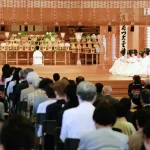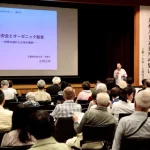The First Oomoto Incident
Onisaburo’s new brand of Shinto, with its internationalist outlook, soon drew the disapproval of the authorities. In 1921, the government arrested the Oomoto leadership and destroyed the headquarters, in what came to be known as the First Oomoto Incident.
Bankyo Dokon
Rather than slowing him down, the First Incident jolted Onisaburo into a new understanding of Oomoto’s international role. In October of 1921, he began dictating his great work Reikai Monogatari (Tales from the Spirit World) which eventually grew to 81 volumes. Sparked by his meeting with a Bahai follower in 1922, Onisaburo became interested in the international language of Esperanto and began making friendships with other religions.
Bankyo Dokon is the title of the 23rd chapter of the Reikai Monogatari, dictated in January 1922. Bankyo Dokon means “All religions spring from the same root”. It states the essence of Oomoto’s belief, rooted in the “Oneness” of Nao’s writings, that all religions are expressions of the same divine impulse.
In 1923, the principle of Bankyo Dokon took concrete shape, when Oomoto forged its first affiliation with another faith, the new Chinese Taoist religion known as Tao Yüan. Tao Yüan worshipped five prophets: Lao-tsu, Sakyamuni, Jesus Christ, Mohammed, and Confucius. For Oomoto, the bond with Tao Yüan was just the beginning.
The Mongolian Expedition

In February 1924, Oni-saburo, while still under investigation by the police during the First Incident, secretly crossed over to the mainland with a small group of followers, bound on a mission to establish a religious utopia in Mongolia. Calling himself “Khan of Mongolia”, “Sakyamuni”, and “The Dalai Lama”, he aimed to rally followers of all faiths to his quixotic vision. However, Onisaburo’s activities drew the ire of Chang Tso-Lin, the warlord of Manchuria, who had him arrested and repatriated to Japan.
Despite its ill-fated ending, Onisaburo’s Mongolian Expedition carried within it the seeds of Oomoto’s ideal of world unity. Onisaburo’s plan called for him to pass beyond Mongolia, through Central Asia, Iran, Turkey, and finally, to Jerusalem. He even had prepared a set of costumes for the Noh play “Queen Mother of the West” which he intended to perform in Jerusalem. The horse-drawn cart carrying Noh costumes destined for Jerusalem rumbling across the Manchurian plains is perhaps one of the most eloquent images for Onisaburo’s world-embracing dreams.



